
A firearm is any type of gun that uses an explosive charge and is designed to be readily carried and used by an individual. The term is legally defined further in different countries.
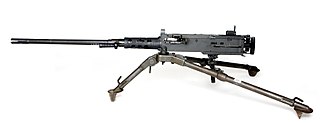
The M2 machine gun or Browning .50 caliber machine gun is a heavy machine gun that was designed near the end of World War I by John Browning. While similar to Browning's M1919 Browning machine gun, which was chambered for the .30-06 cartridge, the M2 uses Browning's larger and more powerful .50 BMG cartridge. The design has had many designations; the official U.S. military designation for the infantry type is Browning Machine Gun, Cal. .50, M2, HB, Flexible. It has been used against infantry, light armored vehicles, watercraft, light fortifications, and low-flying aircraft.

The .50 BMG, also known as 12.7×99mm NATO, and designated as the 50 Browning by the C.I.P., is a .50 in (12.7 mm) caliber cartridge developed for the M2 Browning heavy machine gun in the late 1910s, entering official service in 1921. Under STANAG 4383, it is a standard service cartridge for NATO forces, as well as many non-NATO countries. The cartridge itself has been made in many variants: multiple generations of regular ball, tracer, armor-piercing (AP), incendiary, and saboted sub-caliber rounds. The rounds intended for machine guns are made into a continuous ammunition belt using metallic links.

The FN P90 is a submachine gun chambered for the 5.7×28mm cartridge, also classified as a personal defense weapon, designed and manufactured by FN Herstal in Belgium. Created in response to NATO requests for a replacement for 9×19mm Parabellum firearms, the P90 was designed as a compact but powerful firearm for vehicle crews, operators of crew-served weapons, support personnel, special forces, and counter-terrorist groups.

A rim-fire is a type of metallic cartridge used in firearms where the primer is located within a hollow circumferential rim protruding from the base of its casing. When fired, the gun's firing pin will strike and crush the rim against the edge of the barrel breech, sparking the primer compound within the rim, and in turn ignite the propellant within the case. Invented in 1845 by Louis-Nicolas Flobert, the first rimfire metallic cartridge was the .22 BB Cap cartridge, which consisted of a percussion cap with a bullet attached to the top. While many other different cartridge priming methods have been tried since the early 19th century, such as teat-fire and pinfire, only small caliber rimfire cartridges have survived to the present day with regular use. The .22 Long Rifle rimfire cartridge, introduced in 1887, is by far the most common ammunition found in the world today in terms of units manufactured and sold.
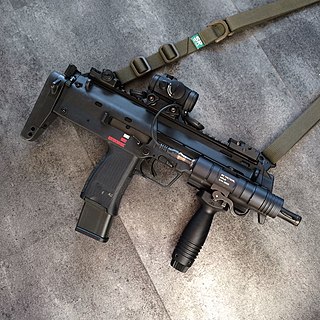
Personal defense weapons (PDWs) are a class of compact, magazine-fed, submachine gun-like automatic firearms designed to fire rifle-like cartridges. Most PDWs fire a small-caliber, high-velocity centerfire bottleneck cartridge resembling a scaled-down intermediate cartridge, essentially making them an "in-between" hybrid between a submachine gun and a carbine.
The .30-06 Springfield cartridge, 7.62×63mm in metric notation, and called the .30 Gov't '06 by Winchester, was introduced to the United States Army in 1906 and later standardized; it remained in military use until the late 1970s. In the cartridge's name, ".30" refers to the nominal caliber of the bullet in inches; "06" refers to the year the cartridge was adopted, 1906. It replaced the .30-03 Springfield, 6mm Lee Navy, and .30-40 Krag cartridges. The .30-06 remained the U.S. Army's primary rifle and machine gun cartridge for nearly 50 years before being replaced by the 7.62×51mm NATO and 5.56×45mm NATO, both of which remain in current U.S. and NATO service. The cartridge remains a very popular sporting round, with ammunition produced by all major manufacturers.
A rim is an external flange that is machined, cast, molded, stamped, or pressed around the bottom of a firearms cartridge. Thus, rimmed cartridges are sometimes called "flanged" cartridges. Almost all cartridges feature an extractor or headspacing rim, in spite of the fact that some cartridges are known as "rimless cartridges". The rim may serve a number of purposes, including providing a lip for the extractor to engage, and sometimes serving to headspace the cartridge.

The 14.5×114mm is a heavy machine gun and anti-materiel rifle cartridge used by the Soviet Union, the former Warsaw Pact, modern Russia, and other countries.

The KPV heavy machine gun is a Soviet designed 14.5×114mm-caliber heavy machine gun, which first entered service as an infantry weapon in 1949. In the 1960s, the infantry version was taken out of production because it was too large and heavy. It was later redesigned for anti-aircraft use, as it showed excellent results as an AA gun against low flying aircraft, with a range of 3,000 m (9,800 ft) horizontally and 2,000 m (6,600 ft) vertically. It was used in the ZPU series of anti-aircraft guns. Its size and power also made it a useful light anti-armour weapon on the BTR series of vehicles and the BRDM-2 scout car.
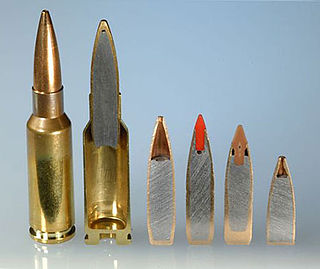
The 6.5mm Grendel is an intermediate cartridge jointly designed by British-American armorer Bill Alexander, competitive shooter Arne Brennan and Lapua ballistician Janne Pohjoispää, as a low-recoil, high-precision rifle cartridge specifically for the AR-15 platform at medium/long range. It is an improved variation of the 6.5mm PPC.

The 4.5mm MKR, also known as the 4.5mm Interdynamic or 4.5mm Kjellgren, was a Swedish prototype rimfire cartridge developed for the prototype Interdynamics MKR bullpup assault rifle and carbine.

A blank-firing adapter or blank-firing attachment (BFA), sometimes called a blank adapter or blank attachment, is a device used in conjunction with blank ammunition for safety reasons, functional reasons or a combination of them both. Blank firing adapters are required for allowing blank ammunition to cycle the bolts of most semi-automatic and automatic firearms. It can also be a safety feature designed to break up the plugs replacing the bullet in military blanks as well as divert the hot gases from a blank discharge out to the sides, reducing the risk of injury to the target of an aimed shot.
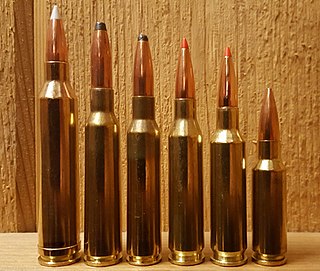
The 6.5mm Creedmoor (6.5×48mm), designated 6.5 Creedmoor by SAAMI, 6,5 Creedmoor by the C.I.P. or 6.5 CM or 6.5 CRDMR for short, is a centerfire rifle cartridge introduced by Hornady in 2007. It was developed by Hornady senior ballistics scientist Dave Emary in partnership with Dennis DeMille, the vice-president of product development at Creedmoor Sports, hence the name. The cartridge is a necked-down modification of the .30 Thompson Center.
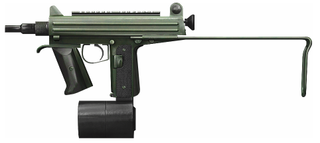
The Saab Bofors Dynamics CBJ-MS is a personal defense weapon/submachine gun designed and manufactured by Swedish weapon developer CBJ Tech AB, and was also manufactured by Saab Bofors Dynamics. It can be chambered for both 6.5×25mm CBJ and 9×19mm Parabellum cartridges via simple barrel changes.

The .224 Boz cartridge was developed in the late 1990s, designed as a candidate replacement cartridge for adoption as the standardized NATO ("STANAG") Personal defense weapon PDW round, originally solicited to replace the longstanding NATO standard (STANAG) 9×19mm Parabellum. It was going to be the British entry, to be evaluated alongside the Belgian FN 5.7x28mm and the German HK 4.6×30mm armor-piercing cartridges. The solicitation would also seek to find, test and standardize a PDW cartridge capable of, at the minimum, defeating the Collaborative Research Into Small Arms Technology (CRISAT) body armour of the time.

The .300 AAC Blackout, also known as 7.62×35mm, is an intermediate cartridge developed in the United States by Advanced Armament Corporation (AAC) for use in the M4 carbine. The cartridge yields increased performance in shorter barrels and effective subsonic performance for silencer use when compared to 5.56mm NATO. The .300 AAC Blackout uses standard 5.56mm NATO magazines and components with the exception of the barrel.

The FN 5.7×28mm is a small-caliber, high-velocity, smokeless-powder, rebated, non-tapered, bottleneck, centerfire cartridge designed for pistols and personal defense weapons (PDW) uses, manufactured by FN Herstal. It is similar in length to the .22 WMR and .22 Hornet. Unlike many new cartridges, it has no parent case; the complete package was developed from scratch by FN.

The Kel-Tec P50 is a FN 5.7×28mm semi-automatic pistol designed in the United States by Kel-Tec in 2021.
















